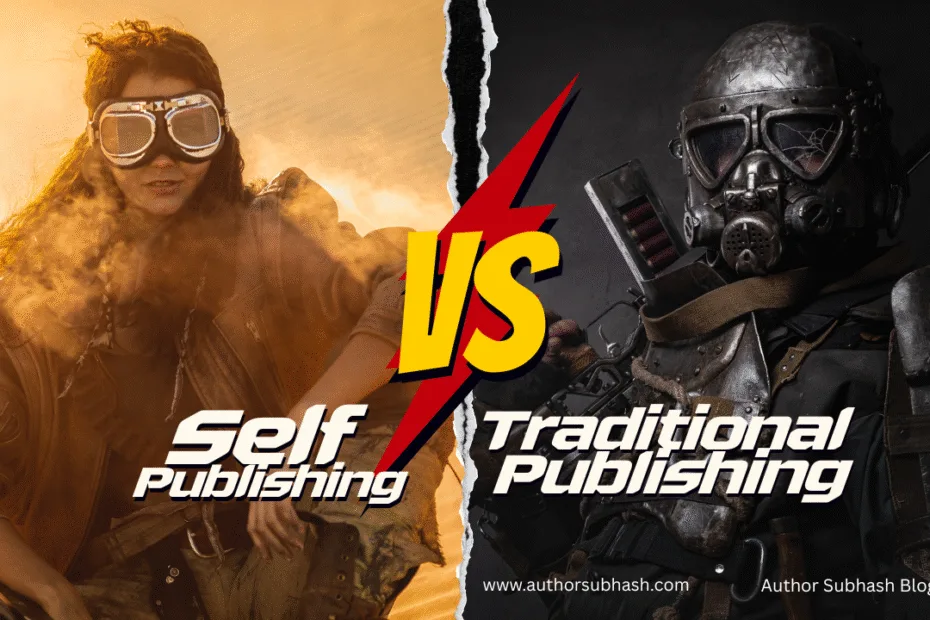Which Path is Right for You?
Every aspiring author in India faces this crossroad —
Should I publish traditionally, or should I self-publish my book?
If you’re holding a completed manuscript (or just an idea) and wondering which way to go, you’re not alone.
Even I stood at this same junction years ago — confused, curious, and searching for the “right” way to reach readers.
The truth?
There’s no single “right” path.
But there is a right path for you — depending on your goals, resources, and personality as a writer.
Let’s explore both sides clearly — so you can make a confident decision.
Traditional Publishing in India
Traditional publishing is the classic route — your book is accepted by a publishing house, they handle editing, printing, distribution, and marketing.
How it works:
- You send your manuscript or proposal to publishers or literary agents.
- If selected, they sign a contract and take charge of publishing costs.
- You receive royalties (usually 7–10%) after sales.
✅ Pros:
- Industry recognition and credibility.
- Professional editing and design.
- Wider offline bookstore reach (Crossword, Oxford, etc.).
- Marketing support in select cases.
❌ Cons:
- Long waiting time (6–12 months).
- High rejection rates — especially for debut authors.
- Limited creative control.
- Royalties are low compared to effort.
Traditional publishing is ideal for authors seeking credibility, awards, or long-term literary reputation.
Self-Publishing in India
Self-publishing empowers you to become your own publisher.
You control everything — content, cover, marketing, and pricing.
How it works:
You can publish your book through platforms like Amazon Kindle (KDP), Notion Press, Blue rose, Pothi.com, or PaperTrue — all within days.
✅ Pros:
- 100% creative control.
- 60–70% royalty on every sale.
- Faster publication.
- Ideal for niche or first-time authors.
❌ Cons:
- You handle editing, design, and marketing yourself (or hire help).
- No guaranteed bookstore presence.
- Requires consistent promotion to succeed.
Self-publishing is perfect for authors who believe in their story and are ready to take charge of their own journey.
How to Choose the Right Path (Mentor’s Advice)
As a mentor, I’ve seen many first-time authors delay their dreams just because they couldn’t decide.
Here’s a simple rule I share with my mentees:
| If You… | Go With… |
|---|---|
| Want prestige & literary reach | Traditional publishing |
| Want speed & control | Self-publishing |
| Want both (hybrid approach) | Start with self, later pitch to traditional (Hybrid Publishing) |
Remember — your goal isn’t to get published, your goal is to get read.
The Hidden Third Path: Hybrid Publishing
In India, hybrid publishing is now a strong alternative.
You invest partially in the process while the publisher offers professional editing, ISBN, and distribution.
It’s faster than traditional publishing and more reliable than DIY self-publishing.
Best hybrid publishers in India include:
Always review contracts carefully and ensure you retain copyright.
Mentor Insight: What Most Authors Don’t Realize
Most authors think the journey ends once the book is published. In truth, publishing is just the beginning.
The real success lies in:
- Finding your ideal readers
- Marketing your book creatively
- Building an author brand
That’s exactly why I created the Golden Draft Mentorship — to help aspiring authors go from idea → written → published → promoted.
Final Thought
Whether you choose traditional or self-publishing, your story deserves to be told.
The best publishing path is the one that keeps your passion alive and connects your words with readers.
Don’t wait for the perfect publisher — become the author who creates your own path.
It depends on your goals. Traditional publishing offers credibility and professional support, while self-publishing gives you control, speed, and higher royalties.
Self-publishing costs in India range from ₹5,000 to ₹50,000, depending on editing, cover design, and distribution services. Platforms like Amazon KDP allow free publishing.
Yes, but it’s challenging. Publishers look for unique ideas, strong manuscripts, and clear author branding. Many first-time authors start with self-publishing first.
Author Subhash Verma, 3X Published author and writing mentor. Contact

Very well presented. Every quote was awesome and thanks for sharing the content. Keep sharing and keep motivating others.
Buddy has done a great job as a social media platform.
I appreciate the honesty in your assessment — refreshing to see.
Hi there to all, for the reason that I am genuinely keen of reading this website’s post to be updated on a regular basis. It carries pleasant stuff.
Your blog is a true hidden gem on the internet. Your thoughtful analysis and engaging writing style set you apart from the crowd. Keep up the excellent work!
Great article! I really appreciate the way you explained everything so clearly – it feels like you put a lot of effort into making it useful for readers.
istanbul